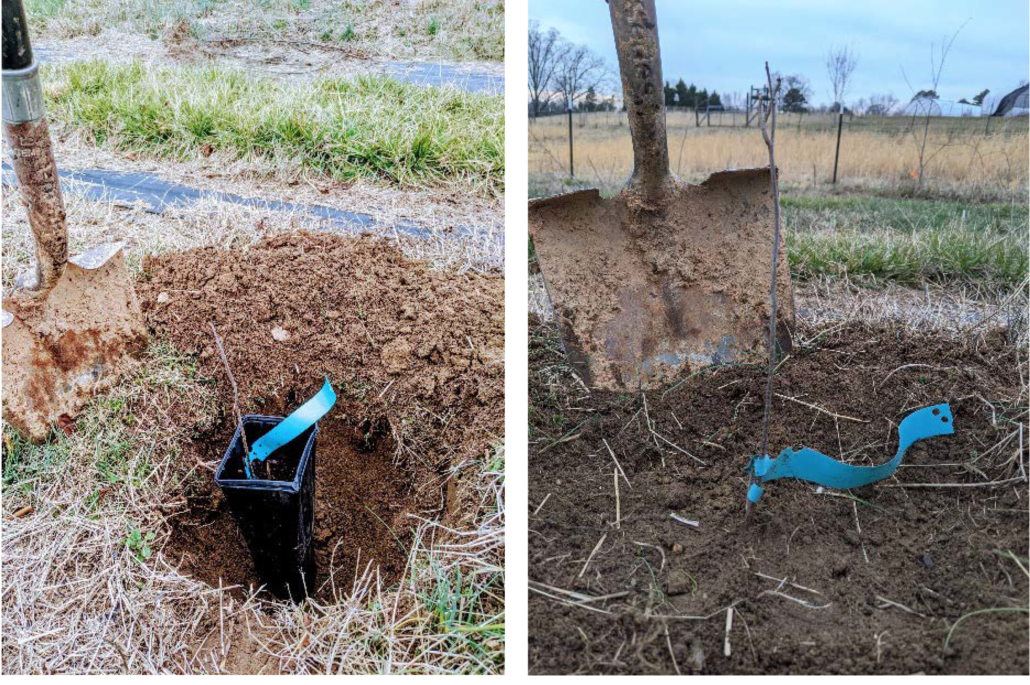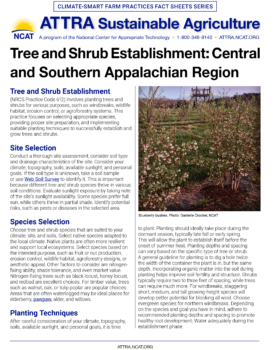Tree and Shrub Establishment: Central and Southern Appalachian Region

Blueberry bushes. Photo: Danielle Crocker, NCAT
CLIMATE-SMART FARM PRACTICES FACT SHEET SERIES
By Danielle Crocker, NCAT Agriculture Specialist
Tree and Shrub Establishment
Tree and Shrub Establishment (NRCS Practice Code 612) involves planting trees and shrubs for various purposes, such as windbreaks, wildlife habitat, erosion control, or agroforestry systems. This practice focuses on selecting appropriate species, providing proper site preparation, and implementing suitable planting techniques to successfully establish and grow trees and shrubs.
Site Selection
Conduct a thorough site assessment; consider soil type and drainage characteristics of the site. Consider your climate, topography, soils, available sunlight, and personal goals. If the soil type is unknown, take a soil sample or use Web Soil Survey to identify it. This is important because different tree and shrub species thrive in various soil conditions. Evaluate sunlight exposure by taking note of the site’s sunlight availability. Some species prefer full sun, while others thrive in partial shade. Identify potential risks, such as pests or diseases in the selected area.
Species Selection
Choose tree and shrub species that are suited to your climate, site, and soils. Select native species adapted to the local climate. Native plants are often more resilient and support local ecosystems. Select species based on the intended purpose, such as fruit or nut production, erosion control, wildlife habitat, agroforestry designs, or aesthetic appeal. Other factors to consider are nitrogen-fixing ability, shade tolerance, and even market value. Nitrogen-fixing trees such as black locust, honey locust, and redbud are excellent choices. For timber value, trees such as walnut, oak, or tulip poplar are popular choices. Areas that are often waterlogged may be ideal places for elderberry, pawpaw, alder, and willows.
Planting Techniques
After careful consideration of your climate, topography, soils, available sunlight, and personal goals, it is time to plant. Planting should ideally take place during the dormant season, typically late fall or early spring. This will allow the plant to establish itself before the onset of summer heat. Planting depths and spacing can vary based on the specific type of tree or shrub. A general guideline for planting is to dig a hole twice the width of the container the plant is in, but the same depth. Incorporating organic matter into the soil during planting helps improve soil fertility and structure. Shrubs typically require two to three feet of spacing, while trees can require much more. For windbreaks, staggering short, medium, and tall growing-height species will develop better potential for blocking all wind. Choose evergreen species for northern windbreaks. Depending on the species and goal you have in mind, adhere to recommended planting depths and spacing to promote healthy root development. Water adequately during the establishment phase.

Planting. Photos: Danielle Crocker, NCAT
Water Management
When planting your trees, be mindful of enhancing water retention in the soil, preventing erosion, and optimizing water-use efficiency. Mulching and/or drip irrigation are ideal options for optimizing water use. Mulch applied around the base of the tree or shrub can improve moisture retention, suppress weeds, and regulate soil temperature. Use terracing or contour techniques to reduce soil erosion on steep hillsides.
Soil Benefits
Healthy soils have elevated levels of microbial activity and organic matter, as well as good soil structure. Trees and shrubs will contribute organic matter from tree litter. Also, microbial activity will increase due to additional tree litter. If you plant late-succession species, your soil will trend toward becoming fungal-dominated, which increases water-holding capacity. Soil structure will improve with the combination of tree and shrub organic matter and sub-soil roots.
Climate Resilience
Trees and shrubs capture carbon dioxide from the atmosphere and store it in their biomass. Sequester additional carbon into agricultural systems by integrating trees and/or shrubs. Enhance the resilience of farming systems to climate change by employing the impacts of trees on temperature (shade) and providing additional income sources.
Conservation Practice Integration
To enhance conservation benefits, integrate tree and shrub establishment with other NRCS practices, such as alley cropping, forest farming, riparian forest buffers, silvopasture, field borders, hedgerow plantings, windbreaks, and/or wildlife habitat. Combining practices creates a more resilient and biodiverse landscape.
Conclusion
Implementing the NRCS Conservation Practice Standard for Tree and Shrub Establishment is a proactive step towards sustainable land management. By following these tips and utilizing NRCS resources, landowners can contribute to environmental conservation, enhance biodiversity, improve soil health, and promote long-term ecological resilience. To learn more about this practice, contact ATTRA.
Further Resources
Agroecological Crop Selection, Part 1. 2024. By Justin Duncan. ATTRA Sustainable Agriculture.
Climate Beneficial Practices. 2023. By Katherine Favor, Lee Rinehart, and Elise Haschke. ATTRA Sustainable Agriculture.
Conservation Practice Standard Tree-Shrub Establishment Code 612. 2023. By USDA Natural Resources Conservation Service.
Fall Planting Fruit Trees. 2020. By Guy Ames. ATTRA Sustainable Agriculture.
Tree and Shrub Establishment: Central and Southern Appalachian Region
By Danielle Crocker, NCAT Agriculture Specialist
Published February 2024
©NCAT
IP654
This publication is produced by the National Center for Appropriate Technology through the ATTRA Sustainable Agriculture program, under a cooperative agreement with USDA Rural Development. This publication was also made possible in part by funding from the Partnership for Climate-Smart Commodities Grant-Building Soils, Building Equity, as administered by the USDA, grant # NR233A750004G024. ATTRA.NCAT.ORG


